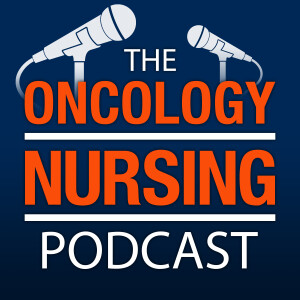
Episode 250: Cancer Symptom Management Basics: Dermatologic Complications
 2023-03-10
2023-03-10
“Sometimes when we talk about skin toxicities, it can get lost in translation for these patients when we start talking about nausea, vomiting, all those other things. . . . They don’t take into consideration how serious these skin toxicities can be and how they can quickly get out of control if they’re not reported to the medical team in a timely manner,” ONS member George Ebanks, MSN, RN, OCN®, a medical oncology nurse in the Cutaneous Oncology Clinic at Moffitt Cancer Center in Tampa, FL, told Jaime Weimer, MSN, RN, AGCNS-BC, AOCNS®, oncology clinical specialist at ONS, during a conversation about symptom management for the dermatologic complications of cancer therapies. You can earn free NCPD contact hours after listening to this episode and completing the evaluation linked below. This episode is part of a series about cancer symptom management basics. The others are linked in the episode notes.
Music Credit: “Fireflies and Stardust” by Kevin MacLeod
Licensed under Creative Commons by Attribution 3.0
Earn 1 contact hour of nursing continuing professional development (NCPD) by listening to the full recording and completing an evaluation at myoutcomes.ons.org by March 10, 2025. The planners and faculty for this episode have no relevant financial relationships with ineligible companies to disclose. ONS is accredited as a provider of NCPD by the American Nurses Credentialing Center’s Commission on Accreditation.
Learning outcome: The learner will report an increase in knowledge related to dermatologic complications.
Episode Notes
- Complete this evaluation for free NCPD.
- Previous Oncology Nursing Podcast episodes on cancer symptom management basics
- Oncology Nursing Podcast Episode 120: Manage Skin Toxicities With ONS Guidelines™
- ONS Voice articles:
- Manage Cancer Treatment-Related Skin Toxicities With ONS Guidelines™
- Diagnose and Manage Dermatologic Toxicity Secondary to Immunotherapy
- ONS Guidelines™ for Cancer Treatment–Related Skin Toxicity
- Clinical Journal of Oncology Nursing articles:
- Skin Toxicities: Common Side Effect
- Radiation Dermatitis: A Prevention Protocol for Patients With Breast Cancer
- ONS book: Cancer Basics (third edition)
- ONS course: Cancer Basics
- National Cancer Institute: Common Terminology Criteria for Adverse Events
To discuss the information in this episode with other oncology nurses, visit the ONS Communities.
To provide feedback or otherwise reach ONS about the podcast, email pubONSVoice@ons.org.
Highlights From Today’s Episode
“The number one thing that I teach my patients is that the skin is their largest organ. It helps protect them from serious events, and we want to maintain that skin integrity because that’s the first line of defense. That’s one starting point there, and I think that helps drive home the point to the patient when you do start to talk about skin toxicities that they do have to take this a little more seriously.” Timestamp (TS) 02:16
“Sometimes when we talk about skin toxicities, it can get lost in translation for these patients when we start talking about nausea, vomiting, all those other things. . . . They don’t take into consideration how serious these skin toxicities can be and how they can quickly get out of control if they’re not reported to the medical team in a timely manner.” TS 14:48
“I started doing this teaching of please, please, please keep a journal so that if this happens again, you know when this toxicity is coming back.” TS 32:06
“One thing we need to remember as nurses is the photosensitivity aspect of these drugs. We need to teach patients that even if they think they’re running outside for five minutes, they need to use SPF 30 or higher and keep as much of their skin covered as they possibly can.” TS 34:28
“One tool that I would encourage you to use is the teach back method with our patients. Have them repeat back to you what you’ve taught them, and keep an eye out. Did they gloss over the rash that you talked about or the skin complication you talked about?” TS 50:15
More Episodes
 2019-10-15
2019-10-15
 2019-08-30
2019-08-30
 2019-08-16
2019-08-16
 2019-08-09
2019-08-09
Create your
podcast in
minutes
- Full-featured podcast site
- Unlimited storage and bandwidth
- Comprehensive podcast stats
- Distribute to Apple Podcasts, Spotify, and more
- Make money with your podcast
It is Free
- Privacy Policy
- Cookie Policy
- Terms of Use
- Consent Preferences
- Copyright © 2015-2024 Podbean.com




